December 31, 2010
A Marble Boat that is not really marble
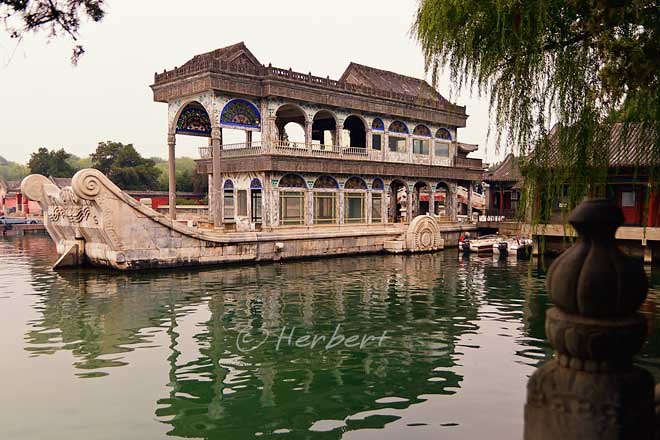
Location: Marble Boat, YiheYuan, Beijing, China(39° 59′ 48.4″ N, 116° 15′ 48.9″ E)
Date: 19 October 2010, 11.10am
Camera: Canon 500D with Sigma 17-70/f2.8-4.5
Yuheyan, the Summer Palace was the summer retreat of the Chinese Emperors/Empress. The Palace is actually a landscape garden with a variety of pavilions, gardens, palaces etc centred around Kunming Lake and Longevity Island. The man-made lake was an imitation of Xihu of Hangzhou and the soil excavated from the lake was used to make Longevity Hill. The Summer Palace was destroyed twice —during the Anglo-French allied invasion of the 1860 2nd Opium War and during the attack by the eight allied powers in the 1900 Boxer Rebellion. The Old Summer Palace (YuanMingYuan) was also destroyed in the 2nd Opium War and was burnt down with looting and plundering of Chinese arts and treasures by British and French soldiers. Whilst the YiheYuan was rebuilt after the 1st destruction, YuanMinYuan was left as it is. Ironically the rebuilding of YiHeYuan by diverting funds originally designated for the Chinese Navy contributed to her second destruction. The destructions of these compounds etched a deep wound in the Chinese psyche as they represent the apex of Chinese humiliation and bullying in the hands of Western powers. These events continue to shape the mind and thinking behind some of China’s foreign and defence policies today.
One of the iconic structure in YiHeYuan is the so-called Marble Boat, a lakeside pavilion on the grounds of the Palace. It is a 2 storey structure which is not actually marble. It has a large stone base with wooden superstructure painted to imitate marble.
December 28, 2010
The “Mosque of the 4 Minarets” of Hyderabad (also known as Cyberabad or Tollywood)
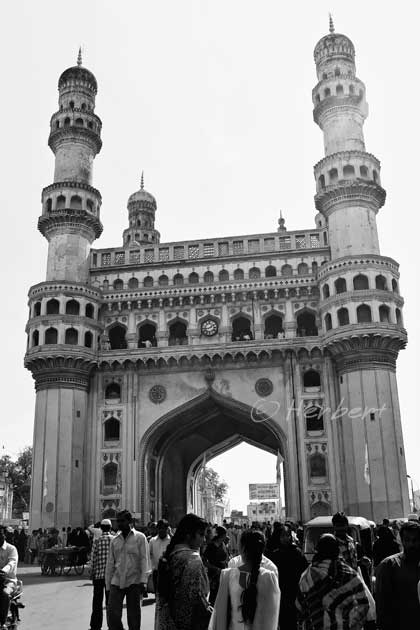
Location: Charminar, Hyderabad, Andhra Pradesh, India (17° 21′ 41″ N, 78° 28′ 28″ E)
Date: 27 November 2005; 2.45pm
Camera: Canon 400D with Sigma 17-70/f2.8-4.5
Hyderabad is the 6th largest city in India. It has developed by leaps-and-bounds in the last few years especially as a major hub in the IT industry, earning itself the nickname “Cyberabad”. It is also the home of the Telugu Film Industry, second biggest only to Bollywood in India; that’s why the city is sometimes referred to as Tollywood. It has a huge Muslim minority and one of the most famous monument of the city is the Charminar literally meaning the Four Minarets. Charminar was built by a Sultan in 1591 after fulfillment of a prayer for the end of a plague that was ravaging the city. The monument is in fact a mosque (on the top floor of the structure) within a fort, made of granite, lime, mortar and pulverised marble. Surrounding the monument is the most bustling bazaar of Hyderabad, the Laad Bazaar. Due to the big Muslim population of the city, Hyderabad has reputedly the best Nasi Biryani (a Muslim rice dish) one can ever find in India.
December 26, 2010
The beautiful Art-Deco building, T & G Building in centre Napier
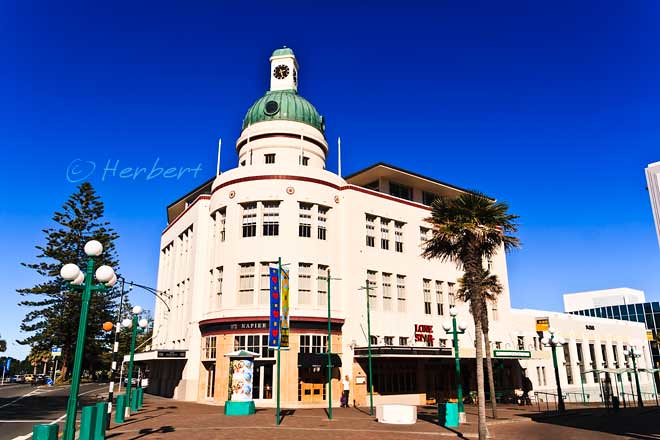
Location: Napier, New Zealand (39° 29′ 0″ S, 176° 55′ 0″ E)
Date: 16 May 2009, 9.40am
Camera: Canon 400D with Sigma 17-70/f2.8-4.5
Napier is one of the so-called “Twin Cities’ on the eastern coast, Hawkes bay, of New Zealand; the other of the twin is Hastings. It is a major port for the region, shipping most of the North Island’s wool, citrus fruits and pulp and timber. The city is more well-known for its Art-Deco buildings. Napier was leveled by an earthquake in 1931 and was rebuilt in the style of the then-popular Art-Deco style. Though many of the buildings had been replaced by more modern designs, most of the Art-Deco buildings in the city center remained intact. Today these are the major tourist attractions though a statue akin to the Mermaid of Copenhagen, known as the Pania of the Reef, is much photographed. Honestly you don’t miss anything if you have not seen the statue.
December 25, 2010
December 22, 2010
One of the most published images of Bangkok- Wat Arun
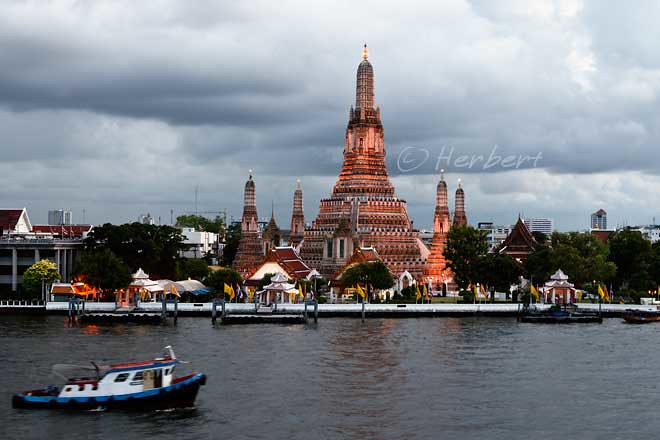
Location: Wat Arun, Bangkok, Thailand (13° 44′ 38″ N, 100° 29′ 19″ E)
Date: 24 June 2010, 6.35pm
Camera: Canon 400D with Canon 70-200/f4.0
Wat Arun is one of the best known landmarks of Bangkok. Situated on the west bank of the Chao Phraya River, it consists of a massive elongated prang (Khmer-style tower), and is surrounded by four smaller prangs. The prangs are decorated by seashells and bits of porcelain which had previously been used as ballast by boats coming to Bangkok from China. It is quite an interesting temple to visit but more stunning to look at from the opposite bank especially during sunset.
December 19, 2010
China is a place to go pick up handicrafts, traditional and modern ones alike
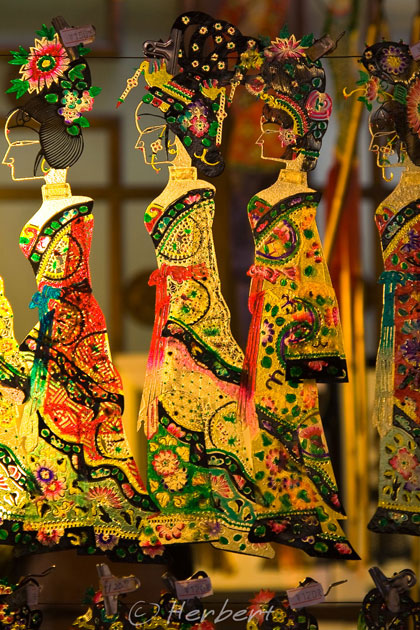
Location: Wuhouci, Chengdu, China (30° 39′ 35″ N, 104° 3′ 48″ E)
Date: 10 October 2008; 2.50pm
Camera: Canon 400D with Canon 70-200 f/4 L IS Lens
One of my favourite activities while travelling in China used to be shopping for handicrafts and collectibles. I enjoyed collecting unique handicrafts- those only produced in very small quantities and perhaps one-of-its-kind and not-too-perfect pieces rather than the factory mass-produced pieces. In the early days when China started opening its doors to outsiders, one can pick up many valuable collectibles at very good prices. For instance, I remembered buying a fabulous wood carvings from bed rests during my first trip in 1996 that used to have a vaunted place on my display shelf. However these days, anything closely resembles uniqueness are very expensive in China. That’s why I do not spend time looking for them anymore- only occasionally browsing just to see what’s in the market. Furthermore I do not have a big enough place to even showcase my current collection- adding more is just going to go to the storage.
December 16, 2010
Amazing hand-blown “flowers” of Bellagio- a must-see of Vegas
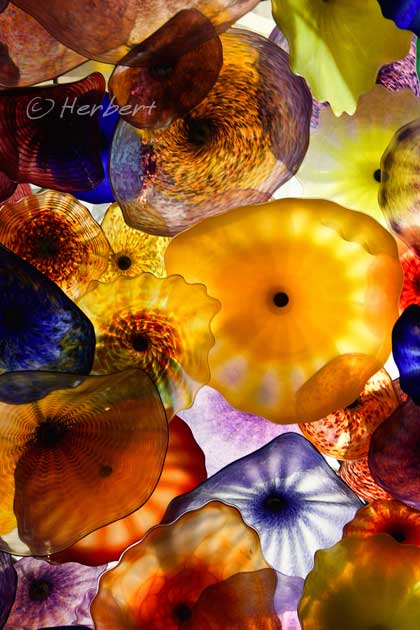
Location: Lobby ceiling of Bellagio Hotel, Las Vegas, Nevada, USA (36° 6′ 47″ N, 115° 10′ 35″ W)
Date: 8 September 2006; 4.15pm
Camera: Canon 300D with kit lens
Las Vegas is really a fun place to go especially for gamblers. Even for non-gamblers like me, it is just fun to hop from hotel to hotel to see the free performances and enjoy the “freak show” so to speak. Amongst other things ,one could see Eiffel Tower and the Pyramid here as well as the most glittering of lights. All the hotels on the Strip of Vegas seem to try to outdo one another all the time, with different themes and attractions. One of the highlights for any Vegas visitors must be the Bellagio Hotel. It has an 8-acre (3.2 ha) man-made lake outside the building which houses the Fountains of Bellagio, a huge dancing fountain with performances synchronized to music and light. Its lobby’ s ceiling is adorned by the “Fiori Di Como” chandelier which comprises of 2,000 hand-blown multi-colored glass blossoms.
December 13, 2010
Srinagar, Kashmir at better times, just a year ago
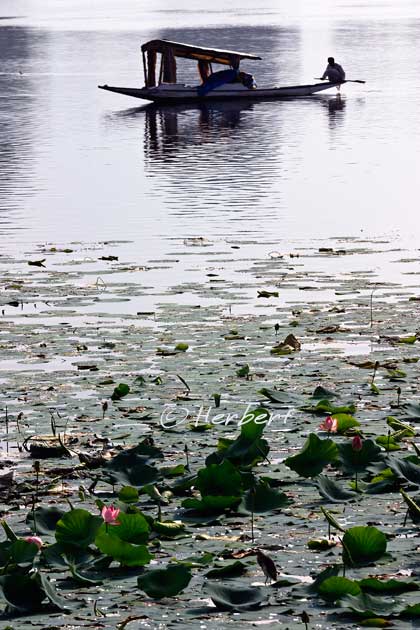
Location: Dal Lake, Srinagar, Kashmir, India (34° 5′ 24″ N, 74° 47′ 24″ E)
Date: 15 August 2009 8.30am
Camera: Canon 400D with Sigma 17-70/f2.8-4.5
This was Dal lake of Srinagar a year ago. Just how much things have changed for the Kashmir Valley in just one year. Protests on the streets of Srinagar in the middle of this year descended into killings of activists and protesters by the Indian Army and Police. The death toll was at least 60, mostly rock-hurling civilians shot dead by police. Whilst the Kashmiri issues are complex and intractable, it is still rather hypocritical of the so-called Western democracies for not raising much of a ruckus to India over the killings. The same cannot be said if the country was Iran or China. Civilian lives often became pieces of pawn on a chessboard to be sacrificed for the greater gains. I was blessed to have the opportunity to visit this beautiful place during one of its most peaceful period and I hope that peace and common sense will again prevail in the Valley very soon.
December 10, 2010
A truly unique Sri Lankan tradition…. stilt fishing
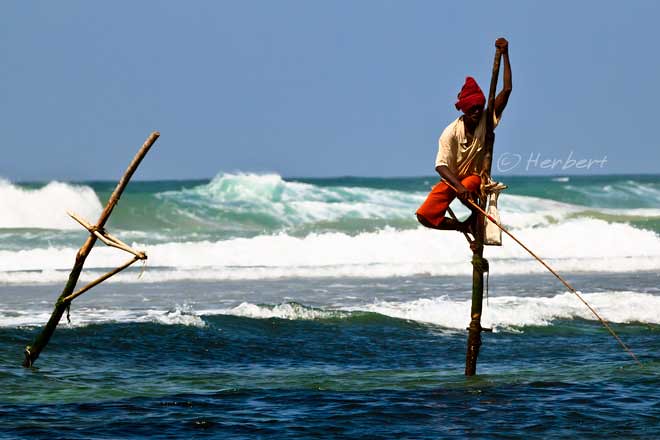
Location: Ahangama, Sri Lanka (5° 58' 40 N, 80° 22' 28 E)
Date: 12 October 2010, 6.10pm
Camera: Canon 500D with Sigma 17-70/f2.8-4.5
One of the most iconic images of Sri Lanka is that of men fishing while perched precariously on poles in the middle of rushing waves.The fishermen sit on a cross bar called a petta tied to a vertical pole planted into the coral reef. They hold the stilt with one hand while fishing with a rod using the other. The poles are about 3-4 m long with about half a meter driven into the reef; so the fishermen is about 2 m above water at high tides. The fishes they catch are small herrings, sardines and mackerels that hang around the shallow reefs. Any fishes caught are stored in a plastic bag tied around their waist or the pole. This is stilt or pole fishing, a tradition that is uniquely Sri Lankan; but a dying tradition with dwindling practitioners. Most stilt fishermen are found on the south and eastern coast of the island. However these days near the tourist resorts along the south coast, there are more so-called stilt fishermen who will pose for a fee for tourists to snap their photos.
December 7, 2010
This should be left standing………………….

Location: Tanjong Pagar KTM Railway Station, Singapore (1° 16′ 22″ N, 103° 50′ 17″ E)
Date: 3 August 2010, 8.35am
Camera: Canon 400D with Sigma 17-70/f2.8-4.5
The Tanjong Pagar Railway Station located in Singapore is the terminus station of the Malaysia Railways (Keretapi Tanah Melayu). The land on which the station and the railway tracks in Singapore are situated is held by KTM on a 999 year lease. The station entrance has statues of white marble, allegories of Agriculture, Industry, Commerce and Transport. Inside the station, there are panel paintings of Malayan scenes: rice planting, rubber tapping, shipping activities, tin mining and so on. Singapore was part of Malaysia until they separated in 1965; when the border control was established after separation, both the Malaysian and Singaporean Customs, Immigration and Quarantine (CIQ) officers were stationed at Tanjong Pagar for immigration clearance of railway passengers even though the station is in fact deep at the other end of Singapore. In 1998 Singapore moved its CIQ functions for railways to Woodlands, which is at the point of entry into Singapore but Malaysia continues to maintain its CIQ functions at Tanjung Pagar. This created a situation whereby rail travellers leaving Singapore actually got checked into Malaysia (technically the station and the railway tracks are Malaysian territories) before they are cleared out from Singapore at Woodlands. This confused state has persisted for the last few years; as a result of a recent agreement between the governments, Malaysia will move its CQ to Woodlands as well by 1 July 2011. The Singapore Government has not being decided as to what will happen to the magnificent Railway Station after the relocation; I personally hope that the station architecture and sculptures will be kept intact.

















